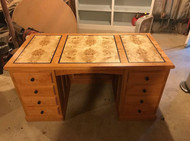One of the most beautiful and prized types of wood veneer is a special type called burl veneer.
This is not a species, nor is it a “type” of veneer in the typical sense of the word. Rather, burl veneer is produced from wood burls, naturally occurring but anomalous wood tissue that creates a very intricate, albeit irregular, and beautiful pattern.
Here’s what you need to know about it.
What Is a Wood Burl? What Is Burl Veneer?
Burl wood comes from “burls” that form naturally on trees.
A wood burl is a growth that forms on a tree, typically above the ground (but sometimes below ground), and grows into an amorphous mass. In a nutshell, burl is formed from bud tissue that fails to sprout or develop properly.
If you’ve ever seen those weird, knurled lumps that sometimes appear on the trunks of trees, you were looking at a burl.
Wood burls form for a wide range of different reasons, but as a general rule they tend to form in response to some sort of stress. Viruses and fungi can both trigger the formation of a burl, as can physical injury to the bark, or to a forming bud. A special type of burl, known as a crown burl, forms near the base of the tree.
As burl wood tissue develops, it is typically full of interconnected, twisted knots and buds that are semi-formed. This gives the burl a very unique grain and structure.
Whereas the grain that grows along the trunk or branch of a tree is generally fairly parallel (with a bit of interlocking in some species) burl wood grain is highly irregular. This makes burlwood very strong, and sometimes very hard.
Burl wood also resists splitting, so for this reason, burl wood has historically been used to make furniture and paneling because it is so durable.
Burl wood veneer is formed by slicing thin sections away from a tree burl and applying a backer to it. As with other forms of veneer, burl veneer is typically more affordable than solid burl wood. However, burl wood veneers are generally the most costly of the veneer sheet selection. Burl veneer is also often beautifully figured and exhibits great variety in form, even within species. For some applications, this makes burl veneer among the most prized of all types of wood veneer.
Popular and Practical Uses for Burl Veneer

Burl wood veneer, like other types of wood veneer, has a wide range of uses.
It is commonly used to produce furniture, and it can also be used to create panelling and accent sections in larger projects.
However, some of the most popular uses of burl veneer are to decorate musical instruments and other home goods, as burl veneer has a unique, irregular grain and often exhibits figure that most consider highly visually appealing.
Burl wood has also been used historically to ornament counters, car dashboards, and gun stocks.
Types of Burl Figure
There are a wide range of different types of burl figures that vary according to species. Some of the most common types of burl figure include the following.
- Clusters: Burl wood grain often forms into tightly swirled figures known as clusters, which can have a wavelike or even dappled pattern.
- Pillow: Pillow figure is sometimes also referred to as quilted figure and refers to folds and blister-like patterns that appear in the surface of the burl.
- Lace: Lace figure in burl is almost exactly what it sounds like; it is a figure that consists of clusters of curls in the grain that look similar to tufts of lace. They are sometimes even compared to veins.
- Bird’s eye: Bird’s eye burl is a beautiful figure that manifests in the presence of multiple small dark spots or rings in the surface of the burl. It is one of the most highly prized figures of all in burl veneer.
High-figure vs. low-figure: You will see in our catalog that some of our burl veneers are classified as “high-figure” and “low-figure.” High-figure burl veneer exhibits a dense variation in figure, whereas low-figure burl appears somewhat more plain or has less contrast.
Popular Burl Veneer Species
Many species of trees produce burls from which veneer can be made, and among these, some are select choices and highly prized for their figure and durability.
Among the most popular burl species are:
- Carpathian Elm burl veneer: Carpathian Elm burl veneer grows on elm trees that live in the Carpathian Mountains in Eastern Europe. Its contrasting light and dark figure is among the most prized in the world among burl species.
- Walnut burl: Walnut burl tends to be very dark brown to almost black and can be lightly or highly figured with stripes and knots.Walnut burl is found in California.
- Redwood burl: Redwood burl veneer tends to have a medium reddish tone with a light background and produces unique figures.Redwood burl is found in California.

- Mappa burl: Mappa burl, like our French burl veneer, is a special type of burl that often exhibits unique tight clusters and pillow figure with contrasting light and dark grain.Mappa burl is found in Europe.
These are only some of the more popular types of burl veneer. We also carry maple, ash, myrtle, white oak, madrone, musk, and laurel burl veneer, among many other species.
Are There Any Special Guidelines I Should Follow for Applying Burl Veneer?
Not really. Burl veneer, like our other types, grades, and species of wood veneer, is available with a variety of different backer types and can be used, and applied, in the same manner, as any other wood veneer.
Questions? Contact Us
Interested in using burl veneer for your next project? We carry a wide range of beautiful, highly figure burl wood veneer sheets and panels. If you still have questions about burl veneer or how to apply it, get in touch with us at 800-426-6018 and we will be glad to help.


